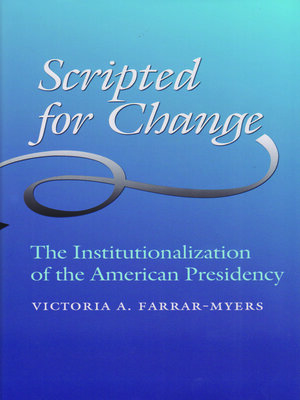Scripted for Change
ebook ∣ The Institutionalization of the American Presidency · Joseph V. Hughes Jr. and Holly O. Hughes Series on the Presidency and Leadership
By Victoria A. Farrar-Myers

Sign up to save your library
With an OverDrive account, you can save your favorite libraries for at-a-glance information about availability. Find out more about OverDrive accounts.
Find this title in Libby, the library reading app by OverDrive.



Search for a digital library with this title
Title found at these libraries:
| Library Name | Distance |
|---|---|
| Loading... |
Without a doubt, the institution of the presidency today is quite different from the one that existed throughout the early part of the nation's history, despite only minimal revisions to its formal constitutional structure. The processes by which the institution of the presidency has developed have remained largely unexamined, however.
Victoria A. Farrar-Myers offers a carefully crafted argument about how changes in presidential authority transform the institution. Her analysis tracks interactions between the president and Congress during the years 1881–1920 in three policy areas: the commitment of troops, the creation of administrative agencies, and the adoption of tariff policy.
Farrar-Myers shows that Congress and the president have in fact "created a coordinated script that provides the basis of precedent for future interactions under similar circumstances." Changes in presidential authority, she argues, "are the residual of everyday actions," which create new shared understandings of expected behavior. As these understandings are reinforced over time, they become interwoven into the institution of the presidency itself. Farrar-Myers's analysis will offer theoretical guidance for political scientists' understanding of the development of presidential authority and the processes that drive the institutionalization of the presidency, and will provide historians with a nuanced understanding of the institution from the period between the end of Reconstruction and the Progressive era.
Victoria A. Farrar-Myers offers a carefully crafted argument about how changes in presidential authority transform the institution. Her analysis tracks interactions between the president and Congress during the years 1881–1920 in three policy areas: the commitment of troops, the creation of administrative agencies, and the adoption of tariff policy.
Farrar-Myers shows that Congress and the president have in fact "created a coordinated script that provides the basis of precedent for future interactions under similar circumstances." Changes in presidential authority, she argues, "are the residual of everyday actions," which create new shared understandings of expected behavior. As these understandings are reinforced over time, they become interwoven into the institution of the presidency itself. Farrar-Myers's analysis will offer theoretical guidance for political scientists' understanding of the development of presidential authority and the processes that drive the institutionalization of the presidency, and will provide historians with a nuanced understanding of the institution from the period between the end of Reconstruction and the Progressive era.







